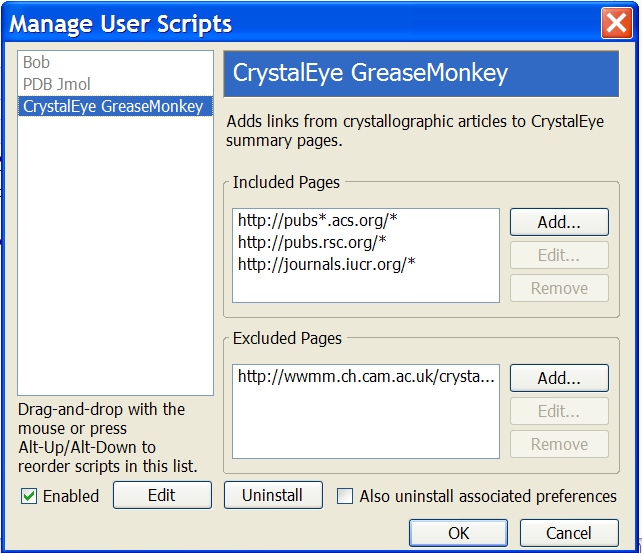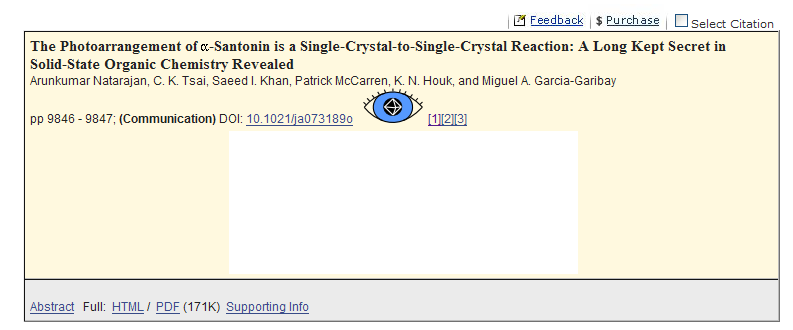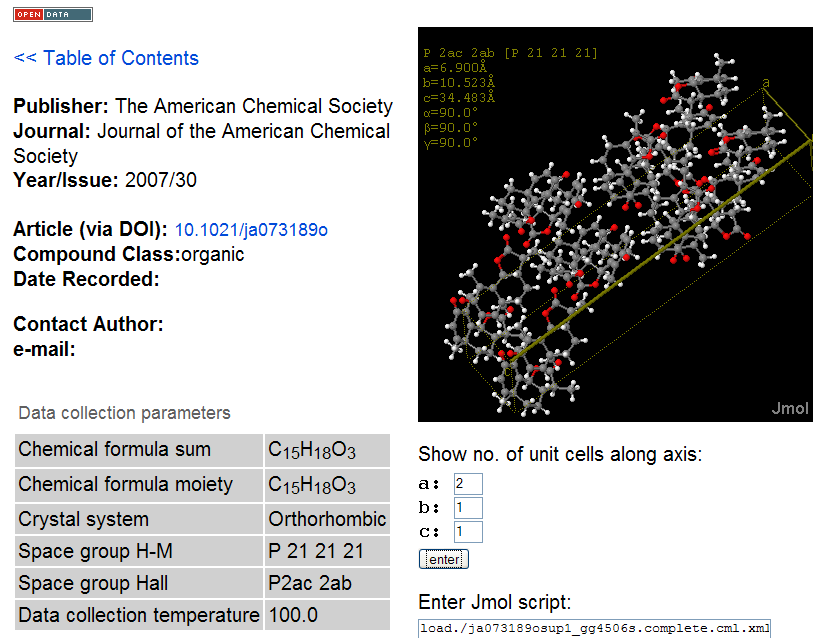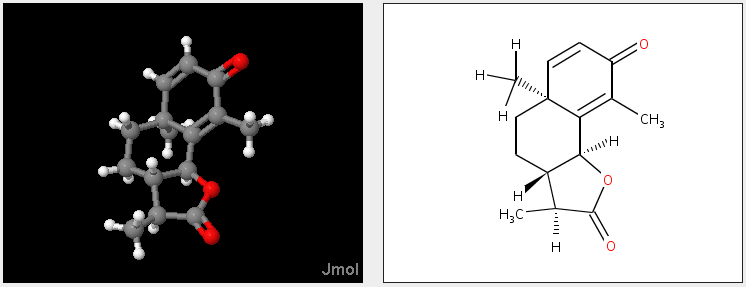Nick Day has just released a Greasemonkey script which provides a full crystallographic overlay for existing journals. It’s worth trying as it’s visually exciting as well as very useful. This post tells you what it does, how it works, and why all publishers will actually benefit from making their crystallographic data Open.
The CrystalEye GreaseMonkey (Javascript) needs to be installed (from http://userscripts.org/scripts/show/11439) inside your Firefox browser. (I don’t believe this is a risk, but make your own decision). It is then activated whenever a new page is loaded from certain sites (e.g. pubs.acs.org/* for any ACS journals). You scan switch in on of off from the box and also decide which sites you wish to visit.

When it finds a DOI in the page (usually from a TOC) it asks the CrystalEye site whether this DOI is listed as one containing one or more crystal structures. (CrystalEye contains over 100,000 crystal structures, most from the last 5 years but some, via the Crystallographic Open Database, going back several decades). CrystalEye returns the addresses of those structures corresponding to the given DOI. The Greasemonkey then adds the CrystalEye logo (I have removed the publisher’s graphic because of copyright).

The blue eye (because this is a BlueObelisk-eyed monkey) indicates crystals and in this case there are three [1][2][3]. Clicking on the first immediately loads the Jmol applet and the metadata:

The links are direct to the publisher’s site and if you have a licence (or if the article is Open Access) you’ll be able to read the fulltext. The material here is all automatically derived from the data (no images or text have been taken). You can even see what we calculate the chemical structure to be:

Again all this is automatic. (Credits to Jmol and – right- CDK structure diagram generator).
So here we have something very close to an overlay journal. No textual commentary, but we are working on that.
So thank you to Dave Martinsen of ACS for reviewing Greasemonkey. And we hope that it increases the clicks on your full-text – people will see the crystal structure and be so excited they will wish to read the full article.
It also works for RSC, IUCr and others like American Mineralogist. But not for Wiley, Springer and Elsevier. Not because we have anything against them, but because they don’t make their structures available. CrystalEye cannot find them, so it can’t point to them. And so, publishers, you are losing out to those publishers who DO expose their crystallography. And perhaps CrystalEye will persuade authors to publish their structures where they can be most seen.
-
Recent Posts
-
Recent Comments
- pm286 on ContentMine at IFLA2017: The future of Libraries and Scholarly Communications
- Hiperterminal on ContentMine at IFLA2017: The future of Libraries and Scholarly Communications
- Next steps for Text & Data Mining | Unlocking Research on Text and Data Mining: Overview
- Publishers prioritize “self-plagiarism” detection over allowing new discoveries | Alex Holcombe's blog on Text and Data Mining: Overview
- Kytriya on Let’s get rid of CC-NC and CC-ND NOW! It really matters
-
Archives
- June 2018
- April 2018
- September 2017
- August 2017
- July 2017
- November 2016
- July 2016
- May 2016
- April 2016
- December 2015
- November 2015
- September 2015
- May 2015
- April 2015
- January 2015
- December 2014
- November 2014
- September 2014
- August 2014
- July 2014
- June 2014
- May 2014
- April 2014
- March 2014
- February 2014
- January 2014
- December 2013
- November 2013
- October 2013
- September 2013
- August 2013
- July 2013
- May 2013
- April 2013
- March 2013
- February 2013
- January 2013
- December 2012
- November 2012
- October 2012
- September 2012
- August 2012
- July 2012
- June 2012
- May 2012
- April 2012
- March 2012
- February 2012
- January 2012
- December 2011
- November 2011
- October 2011
- September 2011
- August 2011
- July 2011
- May 2011
- April 2011
- March 2011
- February 2011
- January 2011
- December 2010
- November 2010
- October 2010
- September 2010
- August 2010
- July 2010
- June 2010
- May 2010
- April 2010
- August 2009
- July 2009
- June 2009
- May 2009
- April 2009
- March 2009
- August 2008
- July 2008
- June 2008
- May 2008
- April 2008
- March 2008
- February 2008
- January 2008
- December 2007
- November 2007
- October 2007
- September 2007
- August 2007
- July 2007
- June 2007
- May 2007
- April 2007
- December 2006
- November 2006
- October 2006
- September 2006
-
Categories
- "virtual communities"
- ahm2007
- berlin5
- blueobelisk
- chemistry
- crystaleye
- cyberscience
- data
- etd2007
- fun
- general
- idcc3
- jisc-theorem
- mkm2007
- nmr
- open issues
- open notebook science
- oscar
- programming for scientists
- publishing
- puzzles
- repositories
- scifoo
- semanticWeb
- theses
- Uncategorized
- www2007
- XML
- xtech2007
-
Meta